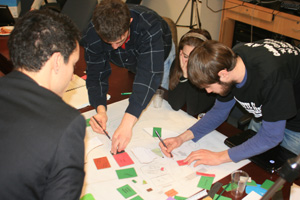Academics and athletics converge as 40 students collaborate with faculty and administrative team on a master plan concept

Metzgar Fields Athletics Complex is going green thanks to a dedicated group of 40 students working alongside faculty and administration. They are developing an innovative master plan concept that incorporates the theme of sustainability while bringing together academics and athletics.
Students from a variety of academic backgrounds are enrolled in the course Sustainable Solutions taught by Arthur Kney and David Veshosky, associate professors of civil and environmental engineering, and Michelle Oswald ’07, a LEED-accredited professional and doctoral candidate at University of Delaware. They also are collaborating with Bruce McCutcheon, director of athletics, Mary Wilford-Hunt, director of facilities planning and construction, George Xiques, manager of sustainability and environmental planning, Mitchell Wein, vice president for finance and administration and treasurer, and Rosemary Bader, director of administrative services and associate treasurer.
The project managers for the class are Diana Hasegan ’10 (Tirgu Mures, Romania), who is pursuing a B.S. civil engineering and A.B. degree with a major in economics and business; Bryan Hendrickson ’10 (Belvidere, N.J.), a civil engineering major; and Connor McGee ’10 (Williamsport, Pa.), chemical engineering major and member of the track and field team.
The students are exploring ways to integrate Metzgar’s current and proposed athletic fields and facilities with academic programs such as the community gardens and composting project, the solar array, and a possible sustainability education center.
“It’s important that we think about long-term approaches to sustainability and realize that solutions to the many problems we are facing today require the kind of group thinking, communication, and collaborative being utilized in the Metzgar project,” says Hendrickson, who plans on traveling to Bogotá, Colombia, after graduation to teach an alternative educational summer camp.
The professors have been impressed with the way their students are taking on a complex challenge.
“Interactive, multidisciplinary projects like this–where students have the opportunity to use Lafayette-learned information and tools–are great because the students get to really test their skills and create a product that is meaningful not only to themselves but also their community,” explains Kney. “Learning and working toward a more sustainable environment and economy is key to the survival of our society, not just one department, discipline, or group of people.”
One of the most unique aspects of the project thus far has been the design charrette, an all-night brain storm where students were divided into three teams and presented their designs to the group.
“It was really rewarding from an instructor’s standpoint to see students engaged in their designs and willing to integrate other perspectives in order to come to a compromising design that includes the strengths of all three teams. This process is directly applicable to what they may experience in the field after they graduate,” says Oswald, who led the charrette and worked with Kney and Veshosky as an undergraduate.
Hasegan calls the charrette “the most intense academic activity I’ve been involved in during my four years at Lafayette.” She says the most valuable lesson she’s taken away from the experience is how to handle professional disagreements.
“When a large team like our design class works on a common goal, there will be conflicts of opinion, differences in character, and opposing ways to deal with problems, which may lead to heated debates,” says Hasegan, who plans to work as a campus organizer for U.S. Public Interest Research Group after graduation. “I have learned how to deal with these situations in a constructive way–how to keep everyone focused on the goal and not on the differences.”
 Metzgar Fields Athletics Complex is going green thanks to a dedicated group of 40 students working alongside faculty and administration. They are developing an innovative master plan concept that incorporates the theme of sustainability while bringing together academics and athletics.
Metzgar Fields Athletics Complex is going green thanks to a dedicated group of 40 students working alongside faculty and administration. They are developing an innovative master plan concept that incorporates the theme of sustainability while bringing together academics and athletics.